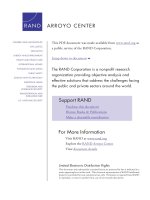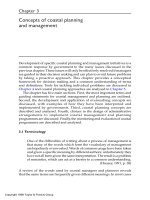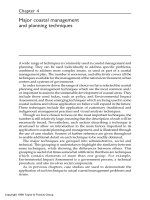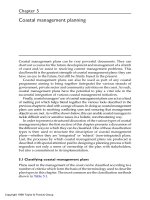Coastal Planning and Management - Chapter 0 pps
Bạn đang xem bản rút gọn của tài liệu. Xem và tải ngay bản đầy đủ của tài liệu tại đây (388.35 KB, 17 trang )
Coastal Planning and
Management
Robert Kay and
Jackie Alder
E & FN SPON
An imprint of Routledge
London and New York
Copyright 1999 Taylor & Francis Group
First published 1999 by E & FN Spon, an imprint of Routledge
11 New Fetter Lane, London EC4P 4EE
This edition published in the Taylor & Francis e-Library, 2002.
Simultaneously published in the USA and Canada
by Routledge
29 West 35th Street, New York, NY 10001
© 1999 Robert Kay & Jacqueline Alder
All rights reserved. No part of this book may be reprinted or reproduced or utilised
in any form or by any electronic, mechanical, or other means, now known or
hereafter invented, including photocopying and recording, or in any information
storage or retrieval system, without permission in writing from the publishers.
The publisher makes no representation, express or implied, with regard to the
accuracy of the information contained in this book and cannot accept any legal
responsibility or liability for any errors or omissions that may be made.
British Library Cataloguing in Publication Data
A catalogue record for this book is available from the British Library
Library of Congress Cataloguing in Publication Data
Kay, Robert (Robert C.)
Coastal planning and management/Robert Kay and Jacqueline Alder.
p. cm.
Includes bibliographical references and index.
ISBN 0-419-24340-2 (hardbound). —ISBN 0-419-24350-X (pbk.)
I. Coastal zone management. I. Alder, Jacqueline, 1954–.
II. Title.
HT391.K36 1999
333.91'7–dc21 98–28804
CIP
ISBN 0-419-24340-2 (hbk)
ISBN 0-419-24350-x (pbk)
ISBN 0-203-01017-5 Master e-book ISBN
ISBN 0-203-13977-1 (Glassbook Format)
Copyright 1999 Taylor & Francis Group
Contents
Foreword by Dr Suvit Yodmani, UNEP
Preface
Credits
Acknowledgements and contributors
1 Introduction
1.1 Coastal areas or coastal zones?
1.2 Defining the coastal area
1.2.1 Scientific definitions of a coastal area
1.2.2 Policy oriented definitions of a coast
1.3 The unique characteristics of coastal areas
1.4 A brief history of coastal management and planning
1.4.1 Sustainability—the dominant pari
coastal planning and management
1.5 Summary
2 Coastal management issues
2.1 Population growth
2.2 Coastal use
2.2.1 Resource exploitation—fisheries, forestry, gas
and oil, and mining
2.2.2 Infrastructure—transportation, ports, harbours,
shoreline protection works and defence
2.2.3 Tourism and recreation
2.2.4 Conservation reserves and protection of
biodiversity
2.3 Impacts of human use
2.3.1 Pollution—industrial, sewage and runoff
2.3.2 Coastal hazards and climate change
Copyright 1999 Taylor & Francis Group
2.4 Administrative issues
2.5 Summary—coastal conflict
3 Concepts of coastal planning and management
3.1 Terminology
3.1.1 What is coastal planning, what is coastal
management and what is the difference?
3.1.2 Placing an emphasis on ‘integration’
3.1.3 Guiding statements for coastal management
and planning
3.1.4 Summary of terminology
3.2 Concepts of coastal management
3.3 Concepts of coastal planning
3.3.1 The theoretical basis of planning
(a) Rational planning
(b) Incremental planning theory
(c) Adaptive planning theory
(d) The consensual planning approach
3.3.2 Summary of the concepts of coastal planning
3.4 Administrative arrangements for coastal planning
and management
3.4.1 Organizing government
(a) Integration and coordination between
levels of government for coastal
management
3.4.2 Linking government with the private sector
and community
3.4.3 Guiding statements for coastal programmes
(a) Coastal programme principles
(b) Overall goal in coastal management
programmes
(c) Coastal programme objectives
(d) Coastal programme action statements
(e) Ownership of guiding statements in
coastal programmes
3.5 Evaluating and monitoring coastal management
programmes
3.6 Chapter summary
4 Major coastal management and planning techniques
4.1 Administrative
Copyright 1999 Taylor & Francis Group
4.1.1 Policy and legislation
(a) Policy
(b) Legislation
4.1.2 Guidelines
4.1.3 Zoning
(a) The mechanics of zoning
(b) Linking zoning with other coastal
planning and management tools
4.1.4 Regulation and enforcement
(a) Regulations, permits and licences
(b) Enforcement
4.2 Social
4.2.1 Customary (traditional) practices
(a) Types of traditional knowledge and
practice in coastal management
(b) Balancing traditional and western
approaches to coastal management
(c) Integrating traditional knowledge, practice
and beliefs into coastal management
programmes
4.2.2 Collaborative and community-based
management
(a) Background to the development of
collaborative and community-based
management
(b) Making the choice: collaborative or
community-based management?
(c) Developing collaborative and community-
based management programmes
(d) Conclusion
4.2.3 Capacity building
(a) Communication, education and training
(b) Research and data management
(c) Section summary
4.2.4 Recreation and tourism management
(a) Concepts of recreation and tourism
management
(b) Recreation and tourism planning
4.3 Technical
4.3.1 Environmental impact assessment
(a) The need for an EIA
(b) Steps in the EIA process
(c) Operational EIA
Copyright 1999 Taylor & Francis Group
(d) Integrating EIA with planning
(e) Strategic environmental assessment
4.3.2 Risk and hazard assessment and
management
(a) Concepts of risk and hazard
(b) The risk and hazard management
process
(c) Mitigating risks and hazards in coastal
planning and management
4.3.3 Landscape and visual resource analysis
(a) Procedure development
(b) Techniques
(c) Application of the techniques
(d) Conclusions
4.3.4 Economic analysis
(a) Economic concepts
(b) Economic analysis tools
(c) Economic instruments
4.4 Chapter summary
5 Coastal management planning
5.1 Classifying coastal management plans
5.1.1 Coastal management plan focus
(a) Strategic planning
(b) Operational planning
5.1.2 Statutory basis of coastal management
plans
5.1.3 The requirements of coastal management
plans
5.1.4 Degree of plan integration
(a) Coast al management subject plans
5.2 Designing a coastal planning framework
5.3 Integrated coastal management plans described
by geographic coverage
5.3.1 International integrated plans
5.3.2 Whole-of-jurisdiction integrated plans
5.3.3 Regional-scale integrated plans
5.3.4 Local area integrated plans
5.3.5 Site-level integrated plans
5.4 Subject plans in coastal management
5.5 Coastal management plan production processes
5.5.1 Consensual-style coastal plan production
processes
Copyright 1999 Taylor & Francis Group
(a) Administrative process
(b) Public participation
(c) Producing the plan
5.6 The implementation of coastal management plans
5.7 Monitoring and evaluation
5.7.1 Monitoring
5.7.2 Programme evaluation
5.8 Chapter summary
6 Conclusions and future directions
Appendices
A Some definitions of the coastal zone for planning and
management
B Examples of texts, conference and workshop proceedings
that outline coastal problems around
the world
References
Copyright 1999 Taylor & Francis Group
Foreword
The rapid increase in population across the globe, large-scale exploitation of
coastal resources and rapid development of infrastructure has often resulted
in severe degradation and decline in the quality of the coastal environment.
These pressures on the coastal zone are certain to intensify in the future.
Mangroves, coral reefs, cliffs, beaches, tidal flats and estuaries are just
some of the coastlines on which pressure is exerted. The complexity of
these ecosystems and their variety across the Asia-Pacific region makes
simple management solutions difficult to find. I am pleased this book not
only recognizes these problems but also offers a range of planning and
management approaches and tools of immense practical value to those
responsible for our valuable coastal resources.
The book has a global perspective and will play a significant part in
assisting the sustainable development of all coastal nations around the
world. Moreover, the coast plays an important part in the lives of many
people living in the Asia-Pacific Region, with over two-thirds of its 3.2
billion people living within the coastal zone. As a result, I believe the book
has particular value to this region.
The links between global and local activities related to coastal
management and planning are important, and are well illustrated in the
book. I am pleased the roles of the various UNEP programmes in facilitating
these linkages are well recognized. The book will be a valuable resource in
assisting the Coastal Zone Management theme of UNEP’s Network for
Environmental Training at the Tertiary Level in the Asia-Pacific.
The mixture of theory and practice of coastal planning and management
demonstrates the importance of combining abstract and technical elements to
achieve the best outcome for the coastal zone. The use of case studies shows
examples of sound practice and differences in approaches around the world.
The case studies also demonstrate the linkage between scales of coastal
planning. Many of these case studies are from developing and developed
countries in the Asia-Pacific region, including Australia, Bangladesh, Indonesia,
New Zealand, the Philippines, Vietnam and Western Samoa.
Copyright 1999 Taylor & Francis Group
The great strength of this book is its emphasis on coastal planning at
different scales. This approach will appeal to all those involved in coastal
zone management, from fisherfolk to government ministers.
Dr Suvit Yodmani
Regional Director and Representative for Asia and the Pacific
United Nations Environment Programme
Regional Office for Asia and the Pacific
Bangkok, Thailand
Copyright 1999 Taylor & Francis Group
Preface
An estimated 50 to 70% of the estimated 5.3 billion people alive today
live in coastal zones.
(Edgren, 1993)
Today, the world’s population in coastal areas is equal to the entire
global population in the 1950s.
(Beukenkamp, Gunther et al., 1993)
In 30 years more people will live in the world’s coastal zones than are
alive today.
(NOAA, 1994a)
Up to 75% of the world population could be living within 60 km of
the shoreline by 2020.
(Edgren, 1993)
Coastlines are the world’s most important and intensely used of all areas
settled by humans. It is this simple fact that directs special attention to the
planning and management of coastlines. Coastal resources have been, and
will continue to be, placed under multiple, intense and often competing
pressures. The use of techniques which attempt to assist in managing the
resulting conflicts in a sustainable way will therefore become increasingly
important in both developed and developing countries.
Translating sustainable development principles into tangible actions
aimed at improving the long-term management of coastal areas is the main
purpose of this book. We do this by providing practical guidance through
the dual use of theoretical analysis and numerous examples of best practice
from around the world. We draw on our personal experience and the
contributions of practising coastal planners, managers and academics from
three continents.
Copyright 1999 Taylor & Francis Group
We have chosen to focus the book on coastal planning, management
and the nexus between them. We believe that achieving genuine sustainable
development in coastal areas will be extremely difficult, but without proper
planning it will be impossible. Planning helps governments to reconcile
the apparently conflicting aims of sustainable development: to promote
the economic development of coastal resources while attempting to preserve
their ecological, cultural and social uses. We believe a key component of
coastal planning efforts is to harness the energy of coastal residents and
industrial and recreational users in the day-to-day management of coastal
areas. We show practical examples of stakeholder participation in coastal
planning, including collaborative management and co-management
approaches.
One of the biggest challenges faced by governments is to direct financial
and human resources effectively to the management of coastal areas through
administrative systems established on sectoral lines. Sectoral-based systems
of government focus on each part of a government’s operations, such as
transport, employment, health and environment. These systems do not
explicitly focus on the planning and management of discrete geographic
areas, such as coastal areas. Governments have chosen to face this challenge
through various mechanisms to coordinate and/or integrate fuctions within
coastal areas. These mechanisms are critically analysed throughout the book.
Case studies from around the world are used to illustrate sound coastal
planning practices and to show differences in approach. Four groups of
case studies have been selected to provide constant themes at different
planning scales and to provide links between these planning scales, listed
in the table.
Copyright 1999 Taylor & Francis Group
The structure of the book, outlined below, reflects our aim of emphasizing
the current state of best practice coastal area planning and management.
Chapter 1
Coastal areas are introduced, how they are defined, and a brief history of
coastal management is presented; the terminology used throughout the
book is discussed.
Chapter 2
The major issues facing coastal managers today are discussed, together
with the emerging issues likely to be of importance in the future.
Chapter 3
Principles of coastal planning and management are analysed. The chapter
emphasizes sustainable development principles, and how governments
are currently attempting to work towards the implementation of sustainable
coastal policies and practices.
Chapter 4
In this chapter the overall theory of coastal planning and management is
translated into on-the-ground actions. These actions are through a range
of techniques, each of which is described with reference to real-world
examples.
Chapter 5
Coastal planning aids and coastal management processes are described.
The mechanisms and contents of plans and strategies at a range of scales
are critically examined.
Chapter 6
This chapter draws together the major findings of the book and outlines
possible future directions for the management and planning of the coast.
Robert Kay
Jackie Alder
Perth, Western Australia
3 September 1998
Copyright 1999 Taylor & Francis Group
Credits
The authors and publishers would like to thank the following for permission
to reproduce material:
Addison Wesley Longman Ltd (Smith and Mitchell, 1993, Impact
Assessment and Sustainable Resource Management, fig. 4.2); Allen & Unwin
(J.M.Owen, 1993, Program Evaluation: Forms and Approaches, table 2.1); John
De Campo (R.Zigterman and J.De Campo, 1993, Green Island and Reef
Management Plan, Queensland Department of Environment and Heritage,
Great Barrier Reef Marine Park Authority, Cairns City Council, Cairns Port
Authority and Department of Lands, Cairns, Australia); Canadian
Association of Geographers (R.W.Butler, 1980, The concept of a tourist area
cycle of evolution, The Canadian Geographer 24(1), fig. 1); Herman Cesar
(1996, Economic Analysis of Indonesian Coral Reef, Environment Department,
World Bank, Washington DC, tables E-1, E-4); Dunwich Museum; Ian
Dutton (K.Hotta and I.Dutton, 1994, Coastal Management in the Asia-Pacific
Region: Issues and Approaches, Japan International Marine Science and
Technology Federation, fig. 1.2); Elsevier Science Ltd (B.Cicin-Sain, 1993,
Sustainable development and integrated coastal zone management, Ocean
and Coastal Management 21(1–3), fig. 2, table 2); Great Barrier Reef Marine
Park Authority; HMSO (1988, The Tolerability of Risk at Nuclear Power, p. 9);
Kent County Council (Clive Gilbert, 1996, Local government responds to
coastal decline, Coastlines 1996, 2, UK issues diagram); Kluwer Academic
Publishing (S. Gubbay, 1995, Marine Protected Areas, fig. 6.1); Ministry for
Planning, Western Australia (Central Coast Regional Strategy, fig. 14); New
Scentist (H.Gavaghan, 1990, The dangers faced by ships in port, New Scientist
128(1744)); S.Olsen, K.Lowry and M.Kerr (1997, Survey of Current Proposals
and Methods for Evaluating Coastal Managemetn Projects and Programs funded
by International Donors, Report #2200, The Coastal Resources Center,
University of Rhode Island, Narrangasett); Risk Unit, University of East
Anglia (B.A.Soby, A.C.D.Simpson and D.P.Ives, 1993, Integrating Public and
Scientific Judgements into a Tool Kit for managing Food-related Risks. Stage 1:
Literature review and feasibility study, Centre for Environmental Risk Research
Copyright 1999 Taylor & Francis Group
Report No. 16); School for Resource and Environmental Studies, Dalhousie
University, Nova Scotia (H.J. Ruitenbeek, 1991, Mangrove Management: An
Economic Analysis of Management Options with a focus on Bintuni Bay, Irian
Jaya, figs A6.1, A6.3, 4.10, 4.12, tables 2.1, 3.1); Taylor & Francis (R.C.Kay, I
Eliot, B.Caton, G.Morvell and P.Waterman, 1996, A review of the
Intergovernmental Panel on Climate Change’s Common Methodology for
assessing the vulnerability of coastal areas to sea-level rise, Coastal
Management 24(2), fig. 4); John Wiley & Sons, Inc. (Harvey M.Rubinstein,
1987, A Guide to Site and Environmental Planning, fig. 1–2); The World Bank
(J.C.Post and C.G. Lundin (eds), Guidelines for Integrated Coastal Zone
Management, pp. 5–6); World Wide Fund for Nature (S.Gubbay, 1994, Local
Authorities and Integrated Directions for Integrated Coastal Zone
Management, Marine Update, Newsletter of the World Wide Fund for
Nature).
While every effort has been made to contact and acknowledge copyright
holders, any omissions should be reported to the publisher.
Copyright 1999 Taylor & Francis Group
Acknowledgements
We would have been unable to produce this book without the help of a
large number of people. Their dedication and love of the coast has provided
us with the momentum when ours ran low. Our partners—Caro Kay and
Reg Watson—deserve special thanks. This book would simply not exist
without them. The contributors listed below also deserve special thanks.
Their enthusiasm and support lifted us up to carry on with the next task.
In particular we would like to thank for their assistance: Ian Alexander,
Ian Briggs, Herman Cesar, Terry Christiansen, Alan Carman Brown,
Stephanie Clegg, Richard Congor, John DeCampo, Ian Dight, Rili Djohani,
Bill Gladstone, Garry Middle, Mahesh Pradhan, Melanie Price, John Quilty,
Hamish Rennie, Gary Russ, Rob Tucker, Mike Williams and Simon Woodley.
We are also sorry if we have unintentionally overlooked anyone who helped
us.
The editorial team at E&FN Spon, especially Camilla Myers who
encouraged us to start writing this book. Gerry McGill’s editorial patience
and humour is acknowledged.
Robert Kay would also like to acknowledge the support and endorsement
of Mike Paul and Reece Waldock from the Maritime Division of the
Department of Transport. Robert also thanks Ian Eliot and John Dodson,
Department of Geography, University of Western Australia, for supporting
his Adjunct Research Fellowship.
Jackie Alder acknowledges the financial support of the Centre for
Ecosystem Management, Edith Cowan University, in writing this book.
Copyright 1999 Taylor & Francis Group
Hilary Watson was so patient with her mother. Thank you.
Disclaimer
The opinions expressed in this book are the personal opinions of the authors
only. The authors accept responsibility for any accidental errors. These
opinions do not represent the position of the Western Australian
Department of Transport (State Government of Western Australia), or Edith
Cowan University.
Contributors
Case study/technical contributors and general editorial
assistance
John E.Hay
Woodward-Clyde Professor of Environmental Science
School of Environmental and Marine Sciences
University of Auckland
Private Bag 92019
Auckland
New Zealand
Mick Kelly
Climatic Research Unit and Centre for Social and Economic Research
on the Global Environment
School of Environmental and Marine Sciences
University of East Anglia
Norwich NR4 7TJ
United Kingdom
Richard Kenchington
Chief Executive Officer
Great Barrier Reef Marine Park Authority
GPO Box 791
Canberra 2601
Australia
Graham King
Chairman, United Kingdom National Coasts and Estuaries Advisory
Group
Director, Coastal Zone Management Associates
2 Newton Villas, Newtown
Swansea SA3 4SS
Copyright 1999 Taylor & Francis Group
United Kingdom
Alan White
Coastal Resources Management Project
5th Floor
Cebu International Finance
Corporation Towers
North Area, Cebu City
Philippines
Case study/technical contributors
John Cleary (contributor of Section 4.3.3. Landscape and visual resource
analysis)
Visual Resource Officer
Department of Conservation and Land Management
PO Box 104
Como WA 6012
Australia
Ian Dutton
Coastal Resources Center, University of Rhode Island
Coastal Resources Management Project
Jl. Madiun No. 3 Menteng 10320PO
Jakarta Pusat, Indonesia
Greg Fisk
Coastal Planning Section
Queensland Department of the Environment
PO Box 155
Albert Street
Brisbane QLD 4002
Australia (formerly: Centre for the Study of Marine Policy, University
of Delaware, USA)
Simon Gerrard
University of East Anglia, Centre for Environmental Risk Management
Norwich NR4 7TJ
United Kingdom
Copyright 1999 Taylor & Francis Group









